Rommel plays with Minatures for D Day
https://www.youtube.com/watch?v=rRuzjs9T_dw&t=29s
On this day during W.W. 2
-
April 30, 1941. North Africa
Rommel gets Paulus’ permission to attack Tobruk. At 2000 hours, German tanks break through the perimeter under cover of dark and an artillery barrage, Overnight, German infantry overrun several Australian gun posts but some hold out, preventing a complete collapse of the defences. To their right, Italian Brescia Division fails to break in.
Photo: German infantry assault party with tank support on its way through the wire obstacles in front of Tobruk.
Source: worldwar2daybyday
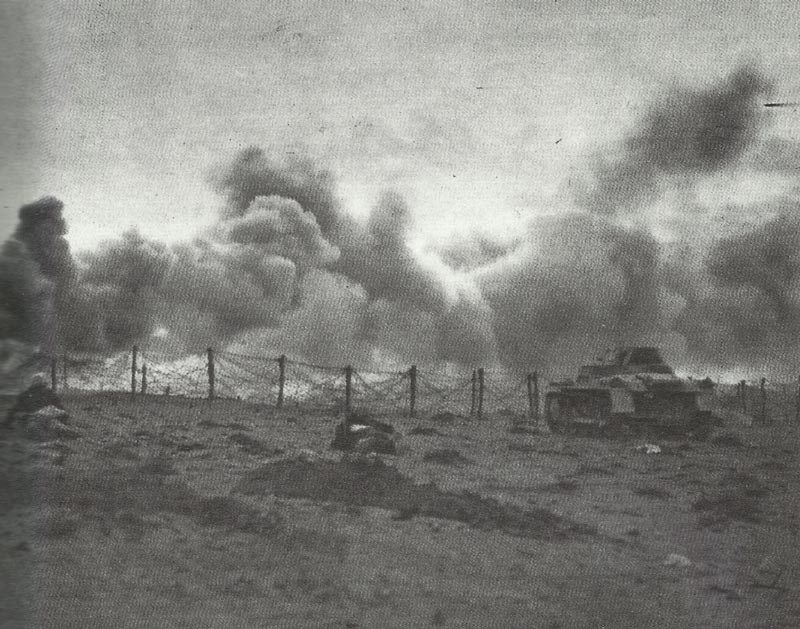
-
It’s ironic that Friedrich Paulus was sent (as an OKH staff officer) to consult with Rommel in April 1941 with regard to the Tobruk operation because a couple of years later there was another overlap between the two officers. The Stalingrad campaign was on its last legs in early 1943, with Paulus and his staff surrendering on January 31st. At the same time, the North Africa campaign was winding down: Tripoli fell to the Allies on January 23; the Allies entered Tunisia in March, and Rommel left for Germany on March 9. Both defeats were bad news for the Axis side.
-
@CWO-Marc Nice observation, Marc.
-
5/3/1945
A BF-109-E was successfully grown from root stock.
-
May 6, 1940. Norway
At Narvik, the Allies tighten the noose around General Dietl’s Regiment. South Wales Borderers (part of British 24th Brigade) are in position 5 miles West of Narvik, while French Chasseurs Alpins and Colonial artillery troops continue to press their attack on Labergdal Pass to the North, across the fjord. Both are held by German perimeter forces. However, Germans bomb Allied ships near Narvik. British cruiser HMS Enterprise is slightly damaged by a near miss (1 Marine killed).
German 2nd Gebirgsjäger Division continues their slow march North from Trondheim to reinforce Dietl’s Regiment.
At 1400 hours, British submarine HMS Sealion attacks German transports Moltkefels and Neidenfels in the Skagerrak. Sealion fires 6 torpedoes, claiming three hits. But all torpedoes miss the targets and the transports are not damaged.
At 1525 hours 30 miles East of Denmark, British submarine HMS Snapper fires 2 torpedoes at German armed merchant cruiser Widder but both miss.
Photo: French troops in the Narvik sector, 1940.
Source: worldwar2daybyday
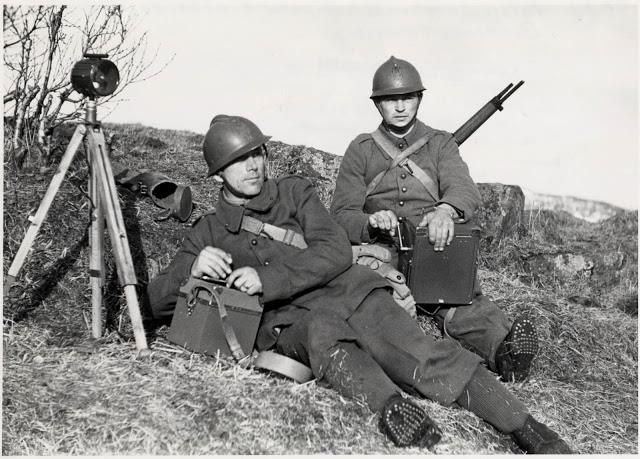
-
May 13, 1940. Western Front
Northern France. In the morning, Rommel sends motorcycle troops across the Meuse River over a weir & lock gate at Dinant, while Guderian’s troops cross in rubber boats at Sedan in the afternoon following intensive bombing of French defensive positions. Despite French artillery bombardment, they both establish bridgeheads and by the evening they have pontoon bridges in place and tanks are rolling over.
Holland. German 9th Panzer Division reaches the outskirts of Rotterdam and 22nd Flieger Division holds onto bridges in the city. Dutch Queen Wilhelmina leaves at noon on HMS Hereward. Her government exiles to London at 17:20 hours on HMS Windsor.
Belgium. Battle of Hannut continues. To cover the Gembloux gap, French tanks line up abreast in a long thin line. Large groups of Panzers easily punch through, causing havoc in the French rear and Prioux retreats to the defensive line at Gembloux. Over 2 days French lost 105 tanks, Germans 160.
Winston Churchill first enters the House of Commons as Prime Minister, accompanied by his predecessor Chamberlain who receives a better reception by far. Churchill gives his “Blood, toil, tears and sweat” speech.
Photo: A Panzer II and other motorised units of the 10th Panzer Division at Wadelincourt, head for the Meuse River on the left flank of the German assault during the Battle of Sedan. May 13 or 15, 1940
Colourised by Royston Colour

-
Panorama of German and Italian prisoners in Tunisia after the capitulation of the African Corps on May 13, 1943.
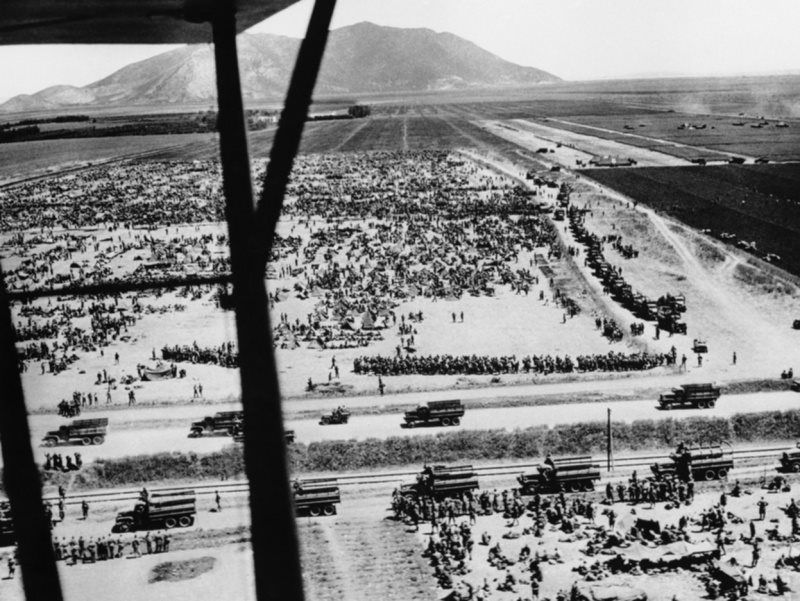
-
May 14, 1942. Eastern Front
Second Battle of Kharkov. Soviets continue advancing West out of the Izyum salient, but Soviet 28th Army, forming the Northern pincer advancing from another salient near Volchansk, is pounded to a standstill by Luftwaffe Fliegerkorps VIII, newly-arrived from the Crimea. Soviet fighters sent in to engage the Germans are decisively beaten despite being numerically superior. Hitler orders General Ewald von Kleist to counterattack with his 1st Panzergruppe. In the Black Sea, Soviet destroyer Dzerzhinski sinks on a Soviet mine near Sevastopol.
Source: worldwar2daybyday

-
@captainwalker Stukas: now I am excited!
-
@Wittmann said in On this day during W.W. 2:
@captainwalker Stukas: now I am excited!
And on that subject, note that the photo correctly shows (for the spring 1942 period) conventional Stukas, not the Ju 87G Kanonenvogel tankbuster version which entered service about a year later and first went into combat at Kursk. The Ju 87G is easily recognizable by its large underwing 37mm cannon pods. To put things in perspective, this was the same caliber gun which was the main weapon of the early versions of the Panzer III.
-
May 15, 1942. Eastern Front
German 11th Army forces the last Soviet troops off the Kerch peninsula linking Crimea to the Caucasus. Soviet losses in the campaign to relieve Sevastopol are 190,000 men killed or captured plus 417 aircraft and several hundred tanks and artillery pieces captured or destroyed. Germans have 12,400 casualties but capture 220 Soviet field guns and 170 tanks. Further North around Kharkov, the Soviet offensive is running out of steam. Soviet attacks continue but meet stiffer German resistance on the ground and overwhelming superiority in the air.
Photo: German Panzer IV and soldiers in the Crimea, 1942.
Source: worldwar2daybyday
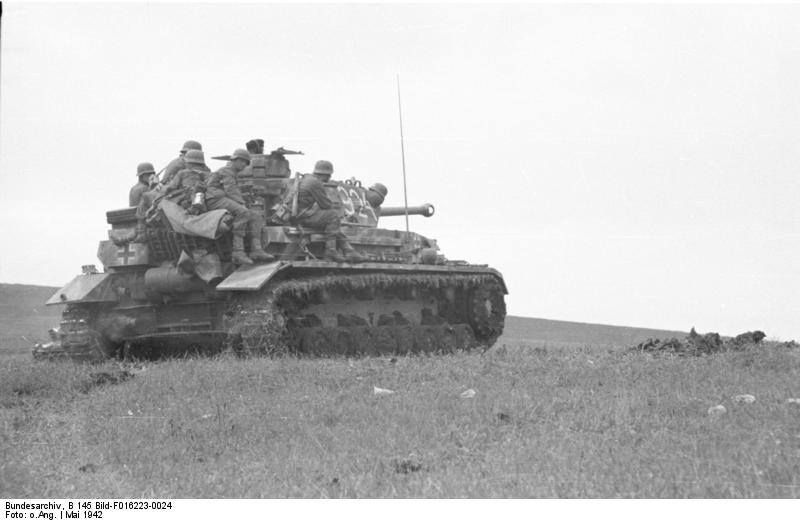
-
A very similar 1942 photo (though taken from the reverse angle) of a troop-laden Panzer III can be seen in the Wikipedia article on Tank Desant, a tactic (which varied from being improvised on the spot to formalized in doctrine) which involved using the outside of tanks as crude infantry carriers. This was fundamentally different from the concept of a true armoured personnel carriers because in the case of an APC the troops are inside the armour (and hence protected), whereas in the case of tank desant the troops are outside the armour (and hence dangerously exposed to enemy fire).
-
May 22, 1941. Crete
Royal Navy has a disastrous day off Crete. They know from Ultra intercepts that a flotilla of small vessels is carrying German troops and supplies from the island of Milos, but this is delayed by the late arrival of Italian escort (torpedo boat Sagittario). British warships search overnight but make the mistake of continuing after sunrise and come under heavy German air attack. At 0100 hours, cruisers HMS Naiad (6 killed) & Calcutta (14 killed) and destroyer HMS Kingston (1 killed) are damaged by bombs. At noon, destroyer HMS Greyhound is sunk (76 killed) and battleship HMS Warspite is badly damaged (43 killed, 69 wounded, under repair in USA until December 18). Anti-aircraft cruisers HMS Gloucester (722 killed) and Fiji (257 killed) try to fend off the Stukas but they run out of ammunition and are sunk. Most survivors from Greyhound, Gloucester & Fiji are rescued by destroyers HMS Kingston & Kandahar.
Photo: HMS Gloucester undertaking evasive manoeuvres prior to being sunk, 22 May 1941. Photograph taken from a Luftwaffe bomber (IWM (HU 24829)).
Source: worldwar2daybyday
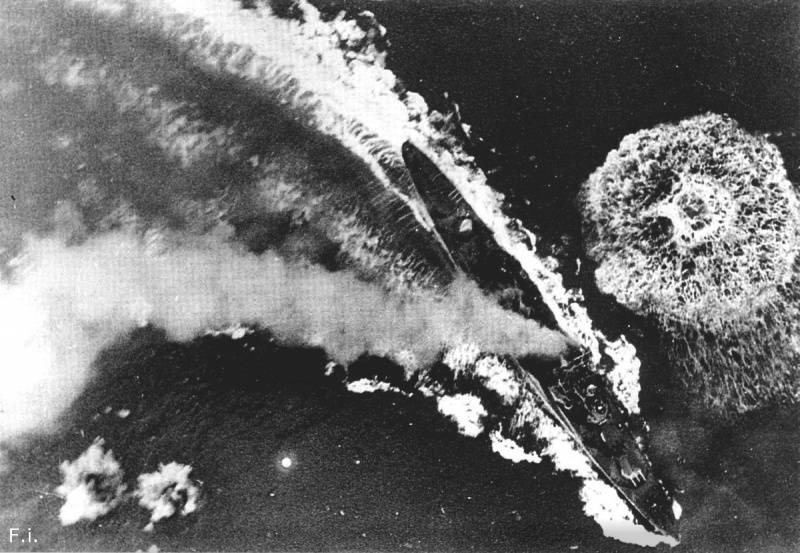
-
Royal Navy have stayed too long in the daylight hunting troopships: Luftwaffe dive-bombers have sunk 3 British cruisers, over 1000 dead; sky over Crete now black from burning ships.
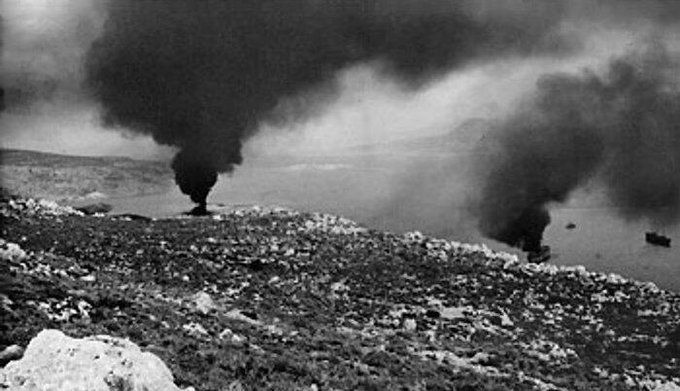
-
May 24, 1941: HMS Hood seen burning on the left while HMS Prince of Wales makes smoke to the right. Shell splashes can be seen falling near the Prince of Wales.
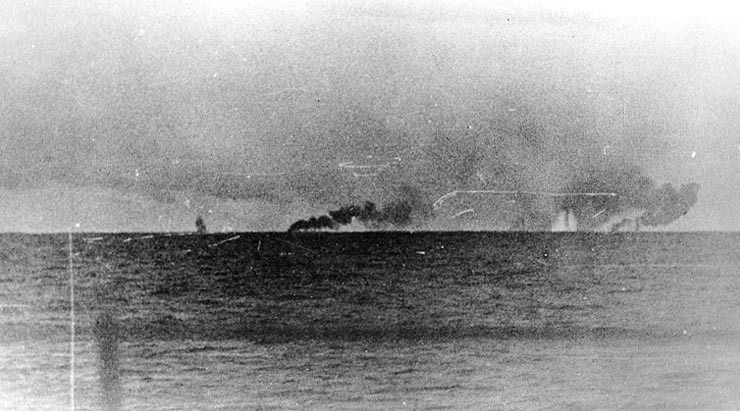
-
A shell from the British Battlecruiser HMS HOOD lands near the German Battleship BISMARK forming a large white column of water. The black smoke near BISMARCK indicates it has just fired a salvo on the British warships." © IWM (HU 382).

-
Bismarck firing on Hood and Prince of Wales, Battle of Denmark Strait, 24 May 1941, photographed from Prinz Eugen.
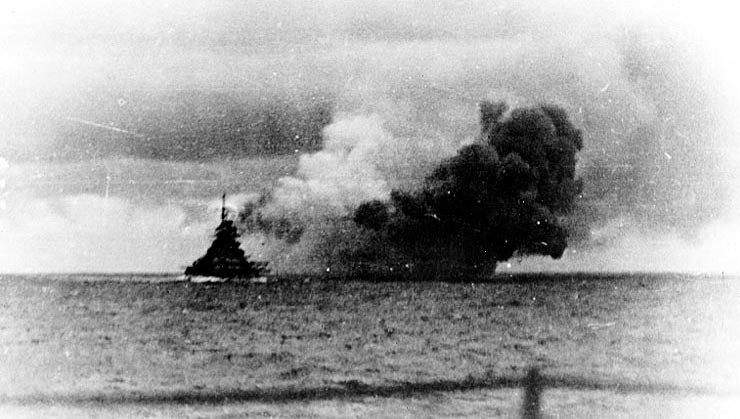
-
May 24, 1941. Battle of Denmark Strait
At 0552 hours, British battlecruiser HMS Hood and battleship HMS Prince of Wales open fire on German battleship Bismarck and cruiser Prinz Eugen from 24 km. Although they outgun the Germans, both British ships have flaws. At 0600 hours, a 15 inch shell from Bismarck penetrates HMS Hood’s thin deck armour, exploding a magazine. Hood is blown in 2 and sinks quickly (1,415 killed, 3 survivors).
HMS Prince of Wales (completed only 2 months earlier) is hit 7 times (13 killed) and retires at 0604 hours with her new guns jammed. Bismarck is hit 3 times (no casualties) but flooding in her bows and a boiler room reduces speed to 28 knots. British cruisers HMS Suffolk and HMS Norfolk continue following Bismarck and Prinz Eugen but at 1800 hours Prinz Eugen escapes South in a squall. At 2350 hours, 8 Swordfish torpedo bombers from British aircraft carrier HMS Victorious attack Bismarck (1 torpedo hits with little damage, 1 killed).
Photo: Bismarck firing on Hood and Prince of Wales, Battle of Denmark Strait, 24 May 1941, photographed from Prinz Eugen.
Source: worldwar2daybyday
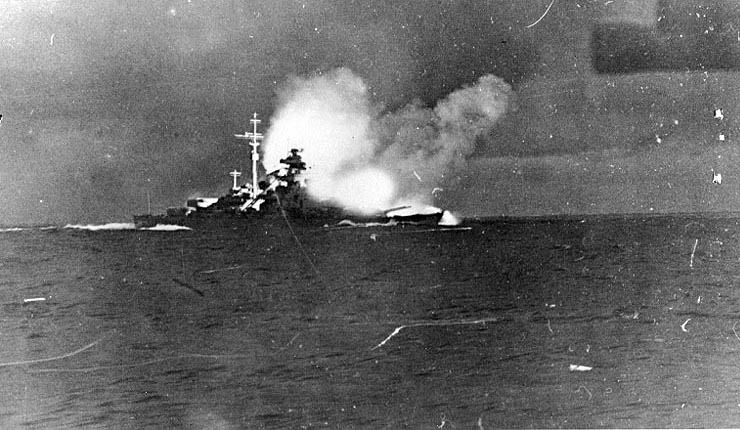
-
@captainwalker
nice hadn’t heard of POWs guns jamming before -
@barnee said in On this day during W.W. 2:
@captainwalker
nice hadn’t heard of POWs guns jamming beforeThere’s a kind of tragic irony to the fact that POW’s jammed in an action in which Britain’s last battlecruiser, HMS Hood, was destroyed by a spectacular explosion of its magazines. The cause of those jams can be traced back to the Battle of Jutland in 1916, in which several British battlecruisers were lost…including HMS Invincible, which also suffered a magazine explosion, and which was commanded by Admiral Horace Hood, a great-great-grandson of Admiral Samuel Hood (after which HMS Hood was named). Britain in 1916 had the world’s largest fleet of battleships and battlecruisers, but Jutland revealed a number of quality-control weaknesses on the British side. One of the problems was that ammunition and propellant hoists in the turret complexes lacked (or only had minimal; I can’t remember which) anti-flash shutters. On the plus side, this increased the rate at which the guns could fire; on the negative side, this made it possible for the blast effects of an enemy hit on a turret to propagate themselves down into the ammunition magazines. Jutland was a shock to the R.N., and it led to a number of changes. One change was that HMS Hood, then under construction, was redesigned and rebuilt, in part to give her more armour (which ultimately proved inadequate in her action against the Bismarck). Another change, however, is that the R.N. started taking anti-flash shutters more seriously. The subsequent irony is that The R.N. overcompensated: POW’s anti-flash shutters were so elaborate that they were finicky and prone to jamming. (It didn’t help that POW was a very new ship and had not fully worked up.)






